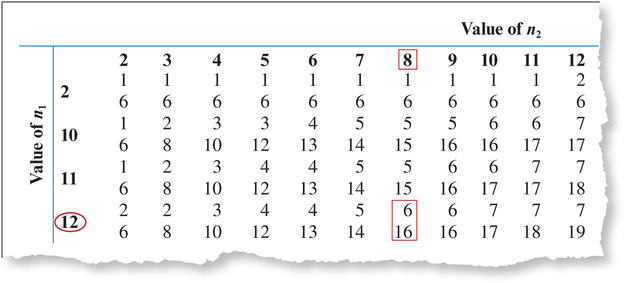EXAMPLE 24 Conducting the runs test for randomness
Test whether the sequence from Example 23 is random by conducting the runs test for randomness, using level of significance α=0.05.
Solution
We know that the data are time-ordered, and that each data value represents one of two distinct outcomes. We may thus proceed with the hypothesis test.
- Step 1 State the hypotheses.
- H0:The sequence of data is random.
- Hα:The sequence of data is not random.
Step 2 Find the critical values, and state the rejection rule. We have n1=12 females and n2=8 males, so the small-sample case applies (n1≤20 and n2≤20). In Appendix Table L we find the row with n1=12 and the column with n2=8, giving us the critical values Gcrit, lower=6 and Gcrit, upper=16 (see Figure 26). We will reject H0 if Gdata≤6 or if Gdata≥16.
Page 14-58 FIGURE 26 Finding the critical values for the runs test for randomness.
FIGURE 26 Finding the critical values for the runs test for randomness.- Step 3 Find the value of the test statistic. We have the small-sample case, so the test statistic Gdata is simply the number of runs, G:
Gdata=G=10
- Step 4 State the conclusion and the interpretation. Because Gdata=10 is not ≤6 and is not ≥16, we do not reject H0. There is insufficient evidence that the sequence is not random.
NOW YOU CAN DO
Exercises 9–20.
[Leave] [Close]